Key takeaways:
- Photography filters, like polarizing and neutral density filters, can dramatically enhance image quality and mood, revealing colors and effects that may otherwise go unnoticed.
- Different types of filters serve unique purposes, such as graduated filters for exposure balance and UV filters for lens protection and clarity in distant landscapes.
- Experimentation with filters fosters creativity and helps photographers discover new artistic avenues, reinforcing the importance of patience and learning through trial and error.
- Taking notes on filter usage and understanding light conditions are practical tips for maximizing the effectiveness of filters in photography.
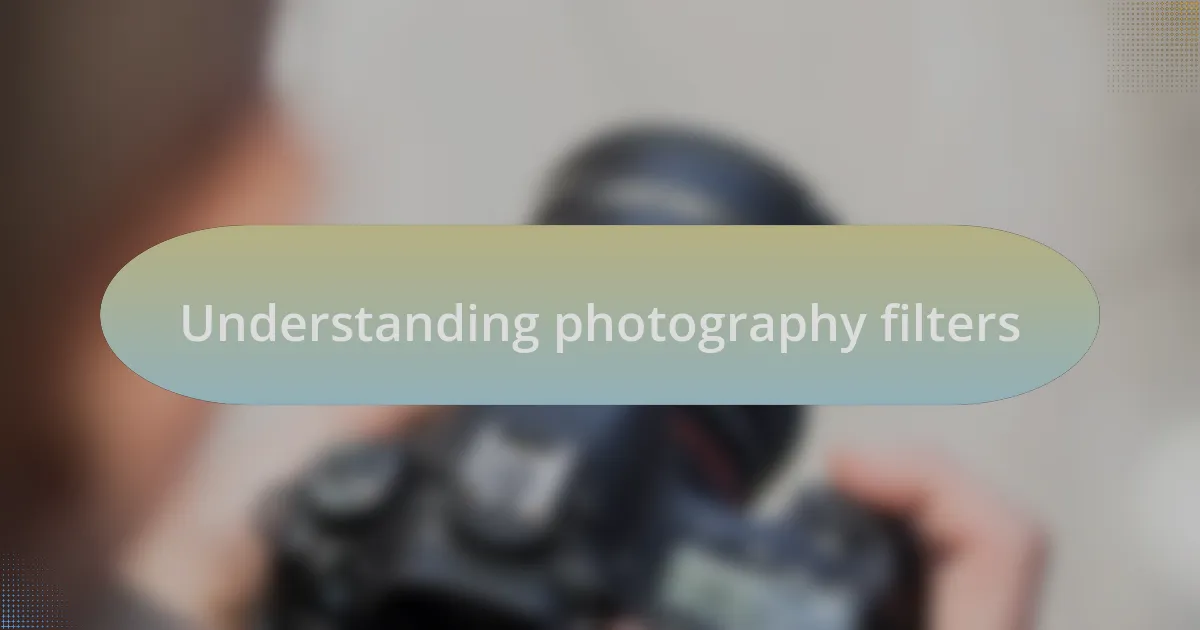
Understanding photography filters
Photography filters are powerful tools that can drastically transform an image’s appearance and mood. I remember my first experience using a polarizing filter; the colors seemed to leap from the photo. Suddenly, the sky was bluer, and the foliage popped in ways I had never noticed before. Isn’t it amazing how a piece of glass can alter your perception of a scene so dramatically?
When I first encountered neutral density filters, I was skeptical about their true purpose. Their ability to reduce light without affecting color blew my mind. I remember standing by a waterfall, trying to capture that silky flow; it was only with an ND filter that I could achieve the dreamy effect I was after. Have you ever tried to slow down time in your images? It’s a surreal experience.
Understanding the different types of filters, like UV or graduated filters, can significantly enhance your photography. Each filter serves a specific purpose, yet they also invite creativity. I often find myself experimenting with various combinations to see how light and shadow play together. Have you ever pushed the boundaries of your creativity through the use of filters? I encourage you to take the leap—it might just unlock new artistic avenues you haven’t explored yet.
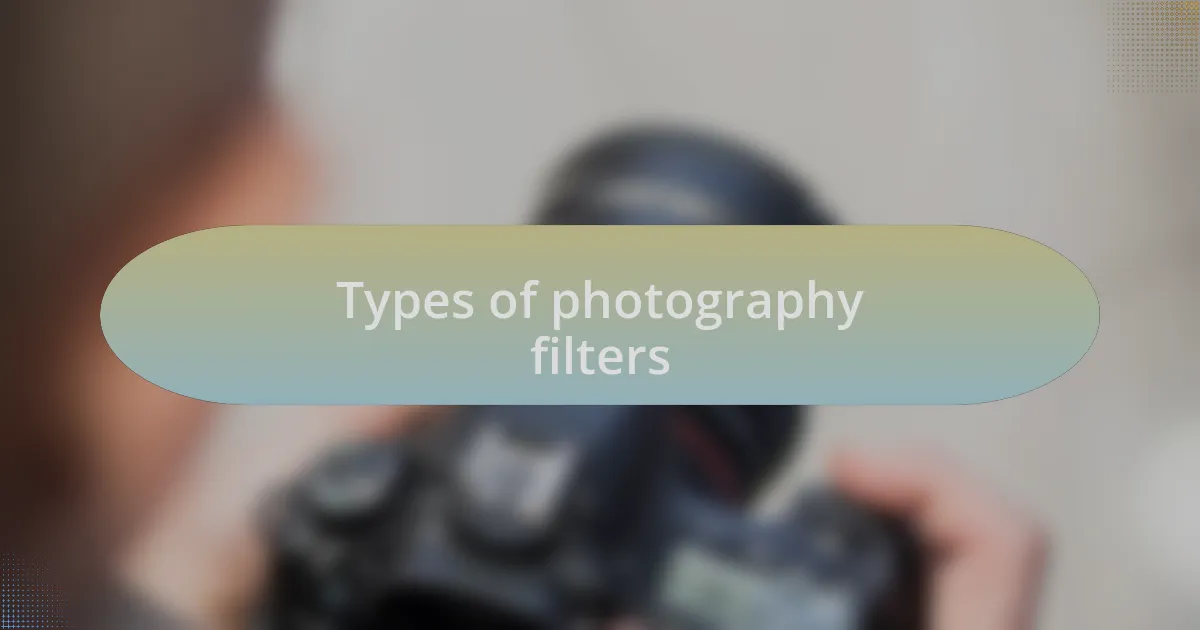
Types of photography filters
There are several types of photography filters, each designed to achieve specific results. For example, a circular polarizer is often my go-to when I’m working with landscapes. I once captured a stunning scene of a lake at sunset, and it was the filter that brought out the reflections so vividly, highlighting the blend of colors in a way that was simply breathtaking. Have you ever experienced that satisfaction of seeing the world through a different lens?
Graduated filters are another essential tool in my kit. These filters have a gradient from clear to tinted, making them perfect for balancing the exposure between a bright sky and a darker landscape. I still remember trying to photograph a sunrise over the mountains without one; the sky was washed out, losing all its magic. It was only after discovering graduated filters that I managed to capture that beautiful transition of colors, which still hangs on my wall as a reminder of that moment.
UV filters might seem like basic additions to your kit, but they offer more than just protection for your lens. Initially, I thought they were unnecessary, but during a trip to a coastal area, I realized how they could help reduce haze, especially in distant landscapes. The difference was astonishing—the clarity improved dramatically, and I ended up with photos that felt more vibrant and engaging. Have you ever found hidden potential in something you initially overlooked? This is the beauty of exploring the different types of filters available to us.
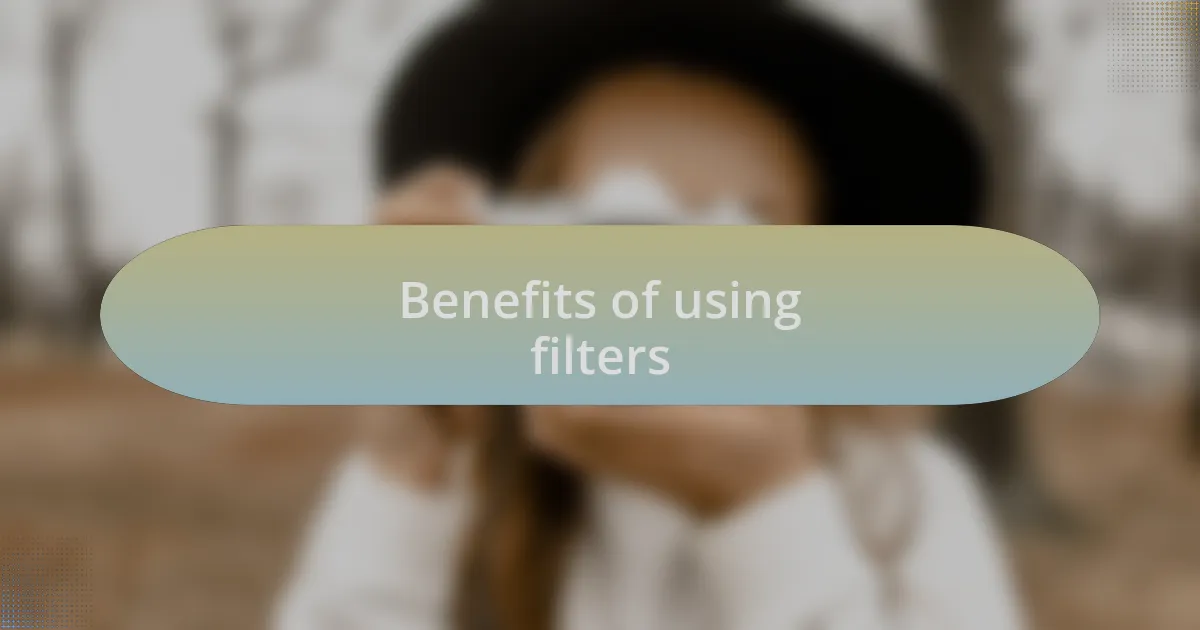
Benefits of using filters
Using filters can truly transform your photography experience, offering benefits that go beyond mere aesthetics. For instance, when I used a neutral density filter during a bustling day at the beach, it allowed me to play with longer exposure times. Suddenly, the chaotic waves turned into soft, flowing silk, creating a serene contrast against the vibrant beachgoers. Isn’t it fascinating how one small piece of glass can change a whole scene?
Another significant advantage of filters is their ability to enhance colors. I once captured a field of wildflowers under a crystal-clear sky with a warm polarizing filter, and the patterns and hues sprang to life in a way that amazed me. It’s moments like these that remind me of the profound impact filters can have; they not only alter the image but elevate the emotion behind it. Have you ever felt a jolt of inspiration just from seeing the colors pop in your photos?
Moreover, filters can protect your lens and extend its life. I realized this when I had an intense shoot in a gritty urban setting. The added layer of protection offered by my UV filter saved my lens from unexpected scratches and dirt. I remember the relief I felt when I checked my gear at the end of the day and found everything intact. Isn’t it comforting to know that with filters, you’re not just creating stunning images, but also safeguarding your valuable equipment?
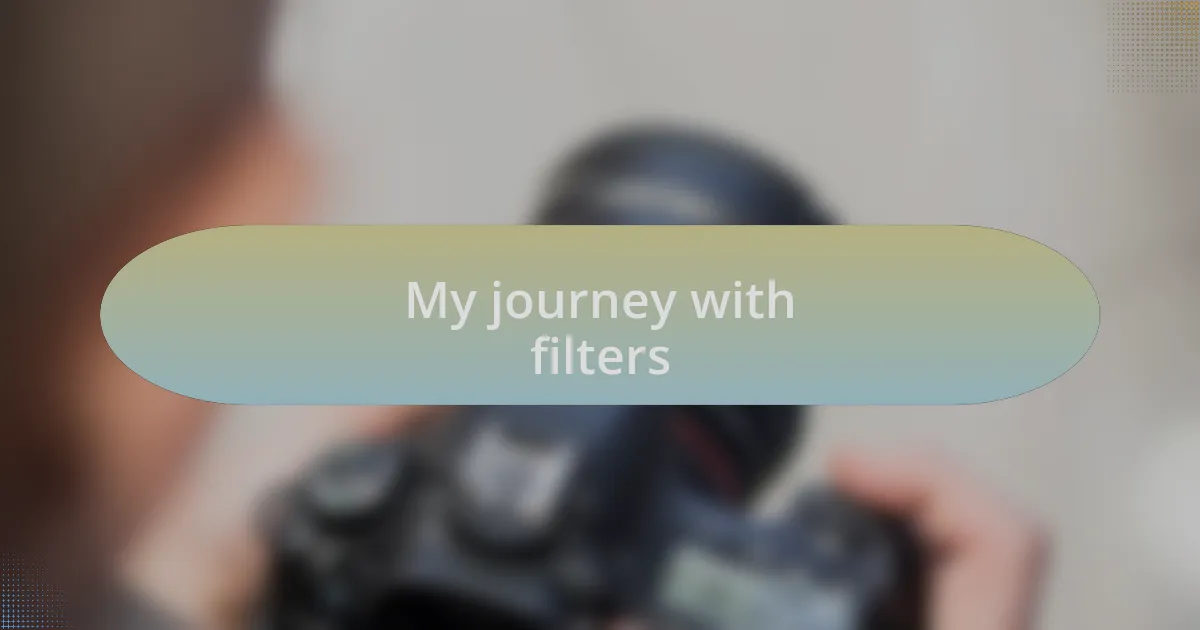
My journey with filters
My journey with filters began with a surprising twist during a golden hour shoot in the mountains. As I experimented with a graduated ND filter, I watched the sunset hues blend effortlessly into the foreground, enriching the landscape’s depth. There was something magical in that moment, as I realized I was painting the scene with light and color—who knew a simple tool could inspire such a shift in perspective?
I recall a day at a local park where I decided to use a color filter for the first time. When I clicked the shutter and saw the vibrant transformation of an ordinary scene into something extraordinary, I couldn’t help but feel a surge of excitement. Have you ever experienced that thrill when something unexpected elevates your creative vision? It reminded me that filters are not just tools; they’re catalysts for creativity.
Reflecting back on my experiences, I can’t ignore the learning curve that came with using filters. The initial confusion about when and how to use them often left me frustrated. Yet, with every mistake I made—like overexposing a sunset shot or losing focus because of a filter’s flare—I gained a deeper understanding of my camera and my vision. Isn’t it interesting how sometimes our greatest lessons come wrapped in frustrating challenges?

Key lessons learned from filters
Using filters has taught me the invaluable lesson of patience. I vividly remember a rainy day where I decided to venture out with a polarizing filter. It took multiple attempts to achieve the desired effect on the wet foliage, and in those moments of waiting for the perfect shot, I learned that true rewards often require perseverance. Have you noticed how sometimes, your best work emerges from the moments of stillness?
Another key takeaway has been the importance of experimentation. I once grabbed a lens with a strong infrared filter on a whim, unaware of the striking otherworldly results it would produce. The surprise of capturing a scene that looked entirely different than usual opened my eyes to endless possibilities. Isn’t it fascinating how stepping outside your comfort zone can lead to the most remarkable discoveries in your photography?
Lastly, I’ve come to appreciate the concept of storytelling through filters. There was a time when I intentionally used a soft-focus filter to evoke a dreamy atmosphere for a portrait session. The feedback I received was heartwarming; people connected with the emotional weight of the images. I find it intriguing how a simple adjustment in technique can pull viewers into a narrative, don’t you? This realization has truly influenced how I approach each shot.
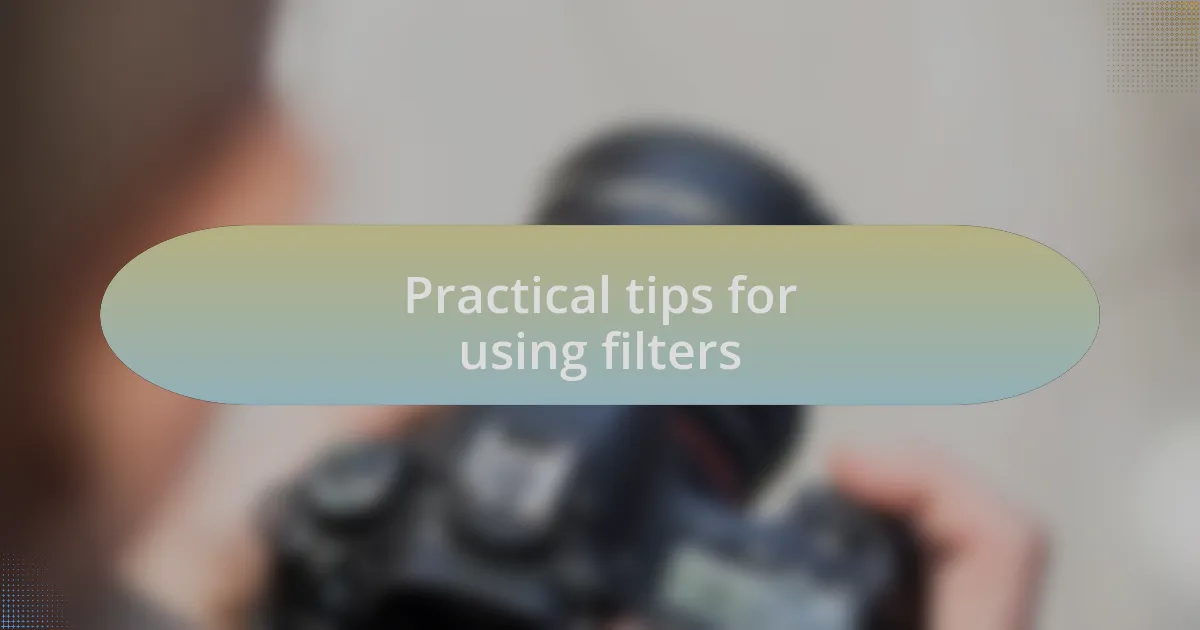
Practical tips for using filters
When it comes to using filters effectively, one practical tip that I’ve found invaluable is to always check the light conditions. I remember a sunset photography session where I forgot to remove a neutral density filter just as the sun dipped below the horizon. The resulting images were far from what I envisioned. Have you experienced similar moments of oversight? By paying closer attention to lighting scenarios, I’ve avoided countless mishaps.
Another essential tip is to take notes on your filter usage during shoots. Not long ago, I shot a landscape series with both a polarizer and a graduated ND filter. At first, I forgot which filter I had used on each shot and struggled to recreate those stunning effects later. Now, I jot down my thoughts and settings whenever I experiment with filters. This habit not only improves my workflow but also sharpens my skills over time. Isn’t it exciting to see your growth as a photographer?
Lastly, don’t overlook the potential of combining filters for unique effects. At a recent beach outing, I stacked a circular polarizer with a warm ND filter. The result was an ethereal blend that accentuated the golden tones in the sand while controlling reflections off the water. This combination significantly transformed the overall mood of my images. Have you ever tried layering filters? It’s moments like these that remind me of the endless creativity we can explore in photography.
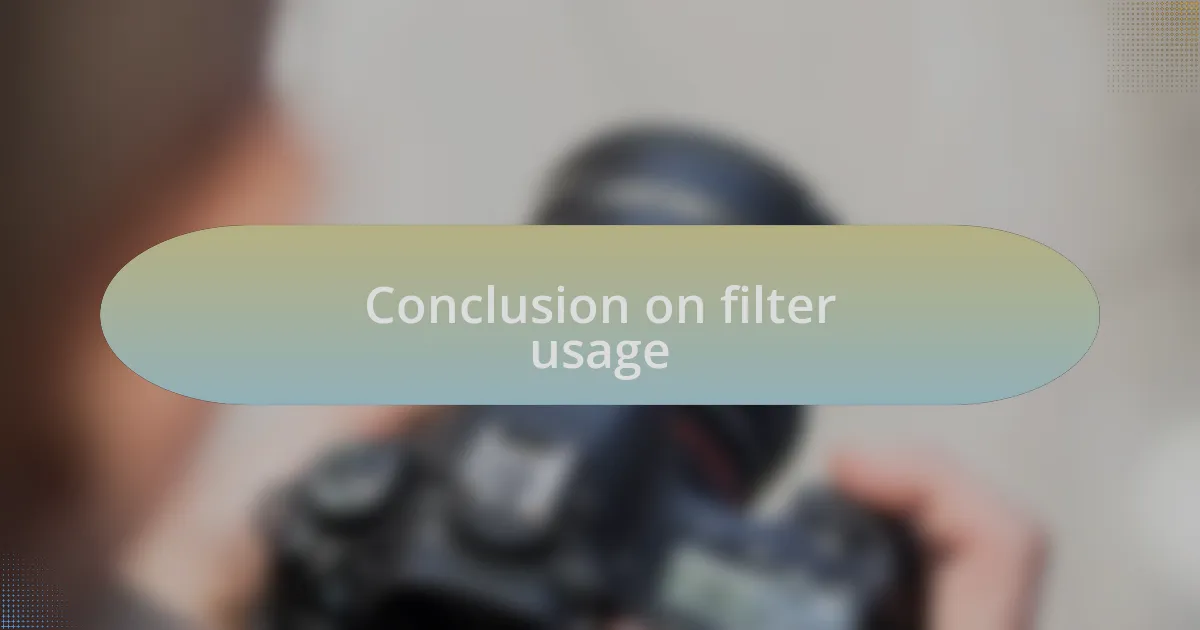
Conclusion on filter usage
Using filters can transform a good photograph into something truly extraordinary. For instance, there was a time when I experimented with a UV filter during a misty morning shoot. The clarity it offered made the soft hues of dawn leap off the frame, leaving me in awe of how a simple addition could elevate my work. Have you ever been surprised by the impact a single filter can have on your shots?
It’s fascinating to reflect on how filters not only enhance technical aspects but also shape our creative vision. I recall a particular session when I applied a warm sunset filter while capturing a bustling cityscape. The glow it added evoked a sense of nostalgia, transporting me back to cherished memories of my own travels. Have you felt that emotional connection to your subject because of filter usage? These moments reinforce the notion that filters are not just tools; they can be gateways to deeper artistic expression.
Ultimately, the journey of learning how to use filters has been an enlightening experience for me. Each trial and error has led to greater confidence in my choices as a photographer. What I’ve truly learned is that filters serve as both a technical aid and a bridge to further creativity. How has experimenting with filters changed your approach to photography? Exploring these possibilities is what keeps the passion alive in our craft.